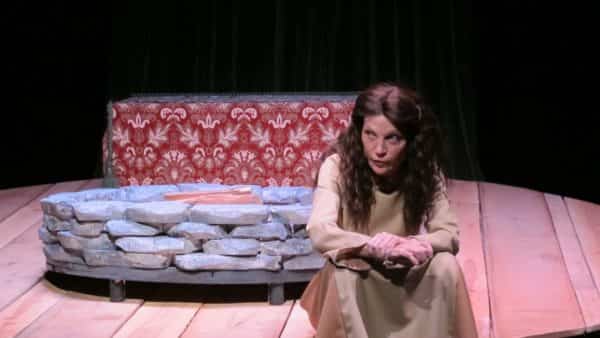Create
Roxanne Fay channels Lady Macbeth in ‘Thrice to Mine’

The characters and scenarios created by William Shakespeare for Macbeth, his epic tragedy of Scotland, were a mash-up of fact (real people and events from history) and fiction (Celtic folk myths, legends, and the fertile fields of the bard’s own mind).
Tampa Bay playwright and actress Roxanne Fay, herself prolific with pen, has crafted a one-person show making its area debut this weekend at@thestudio@620. Thrice to Mine takes its title from this Shakespearean couplet (the “weird sisters” are witches, casting a spell o’er Macbeth and his ever-faithful Banquo):
The weird sisters, hand in hand,
Posters of the sea and land,
Thus do go about, about,
Thrice to thine and thrice to mine,
And thrice again to make up nine.
Peace, the charm’s wound up.
William Shakespeare, Macbeth, Act 1, Scene 3
But Fay’s Thrice to Mine, while it includes echoes of Shakespeare in both deed and dialogue, was drawn up from a much deeper well: The actual historical record.
Fay portrays Gruadth, Daughter of the Thane of Fife, about whom little is known – the lineage from so long ago is understandably murky. She was, however, a real person, and thought to be one of the inspirations for the devious and doomed Lady Macbeth.
Shakespeare, Fay explains, took ideas from Holinshed’s Chronicles, an “historical record” of England, Scotland and Ireland. Published in the late 16th Century, the book blended historical fact and fiction.
And so all’s fair in love, war and playwriting.
Thrice to Mine had its genesis during Fay’s 2018 visit to Lasswade, Scotland, where she was a writer in residence at artist-friendly Hawthornden Castle.
“I was working, at the time, on two separate ideas,” she explains. “A one-woman show about Lady Macbeth, and an adaptation of Shakespeare’s Macbeth that was told exclusively by the three witches.
“When I got there, there were four very large libraries on the property. And the wealth of Scottish history really engaged me. And I kind of abandoned the Shakespeare project for a while; I haven’t come back to it yet.”
Thus she started down another path: “The facts,” Fay says, “were a lot more interesting than the fiction.”
For 90 minutes, Fay will be alone onstage, as Gruadth tells her story. “I’ve woven a lot of Celtic myth and magic, and Pagan rites, into the piece. She is a Pagan; she’s been raised in the Celtic rituals. Her mother was very gifted in charms and spells – what they called the second sight. That’s all conjecture.
“So I used that to have her hear things; she hears voices in the wind. Prophesy. And those are the voices of the weird sisters. In most cases, they speak either Shakespeare’s words, or they speak something that I’ve taken out of Celtic prophesy and put in their mouths, to put in her ear.”
Thrice to Mine was first performed in August at Bridge Street Theatre, a repertory venue in Catskill, N.Y. Bridge Street, where all of Fay’s original works have been staged, put it in rotation with Gareth Armstrong’s Shylock, a one-man “re-consideration” of a character from Shakespeare’s The Merchant of Venice.
It is too easy to say this is Lady Macbeth as a character in “Game of Thrones,” but the thoroughly imagined world and life that Ms. Fay has created in her conception, writing and performance beg for some comparative accomplishment. It is an epic, earthly yet mystical adventure of a woman’s triumphant survival in the 11th century.
A review, by Patrick White/Nippertown
Although she has performed at every one of Tampa Bay’s professional theaters, as a member of an always-fine cast, Fay retains a soft spot for the one-woman show (among other things, she portrays Salvador Dali’s wife Gala in playwright Heather Jones’ Unspeakable Confessions each September at the Dali Museum).
In 2014, she wrote and performed Upon This Rock: The Magdalene Speaks, a first-person narrative “by” Mary Magdalene.
Upon This Rock was taken from her novel of the same name (she cut it down to create a “presentational monologue”). Thrice to Mine, Fay says, went through a very similar process. She gets in, deep.
“If you write a story, there’s a reason that you want to tell the story,” she enthuses. “There’s something in you. And there’s a passion about telling this particular story that is more intimate when you are the person who created it. So the need to communicate is stronger. And I think it connects you to your audience more strongly.
“And also, you’re the one who has the vision in your head. You know what this person looks like, what they sound like. You can feel it.”
Thrice to Mine is performed Friday and Saturday evenings. Details and tickets here.







